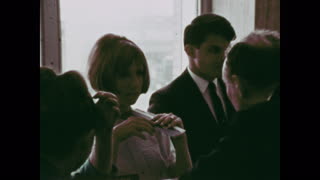An airliner comes in for a landing in the opening seconds of the circa 1967 National Aeronautics and Space Administration color film “Flight to Tomorrow” as the narrator reminds the viewer that there are more than 300 major airports across the United States. On a typical day, more than 1,100 airplanes take off and land at John F. Kennedy Airport in New York City (and 37 million across the United States), as more aircraft are shown landing and we see scenes of some of the 77,000 travelers who make their way through their airport daily. The viewer is taken inside a cockpit at take-off before being taken back in time at mark 03:11 to the early days of flight — with all of its successes and failures. By 1915, the National Advisory Committee for Aeronautics (NASA’s predecessor) was created to supervise and direct the scientific study of flight. From scenes of single-piston planes to supersonic jets, the narrator explains how some planes are able to reach the edge of space. Such scientific pursuits are also used in commercial transportation, and at mark 05:10 we’re taken back inside an airplane and news of how a five-hour, 3,000-mile trip across the United States may one day be whittled down to half that time thanks to a supersonic transport (SST), shown at mark 05:30 and the film takes several minutes discussing its design and possible use. News of new lubricants and metals needed to survive longer flight times comes at mark 10:35, as is news of how scientists also are working on ways to address turbulence and other issues in flight so that planes might be as easy to fly as a car is to drive. At mark 15:13 we turn to see scenes of additional experiments being undertaken regarding the development of the SST, and at mark 17:25 visit the topic of noise pollution. NASA pilots and engineers, we’re told, are continuously working to find ways to minimize the noises that naturally accompany commercial flight, including making steeper approaches to landing which uses less power and as a result, less noise. As a jet engine whines at mark 18:12, an XB-70 Valkerie flies by. At 19:13, temporary houses are seen at Edwards AFB where families are subjected to sonic boom and aircraft noise. Engineers conduct experiments to find ways to make it operate more quietly. By mark 19:55, we also told NASA scientists are not working on supersonic transport but also hypersonic transports (HST) which will fly at 4,000 miles an hour — crossing the United States in less than an hour. Such an aircraft may be ready — late 1960s audiences were told — within 20 years, as only 20 years had passed since the first Bell X-1 supersonic aircraft gave way to the X-15. Even without such aircraft, the narrator says “short haul” routes, such as those between Los Angeles and San Francisco that take about an hour, may increase one day to alleviate congested roadways. To that end, researchers are shown testing vertical and/or short take-off and landing V/STOL aircraft at mark 23:00 to make it possible for people to live in the country and work in the city.
We encourage viewers to add comments and, especially, to provide additional information about our videos by adding a comment! See something interesting? Tell people what it is and what they can see by writing something for example: “01:00:12:00 — President Roosevelt is seen meeting with Winston Churchill at the Quebec Conference.”
This film is part of the Periscope Film LLC archive, one of the largest historic military, transportation, and aviation stock footage collections in the USA. Entirely film backed, this material is available for licensing in 24p HD, 2k and 4k. For more information visit http://www.PeriscopeFilm.com


